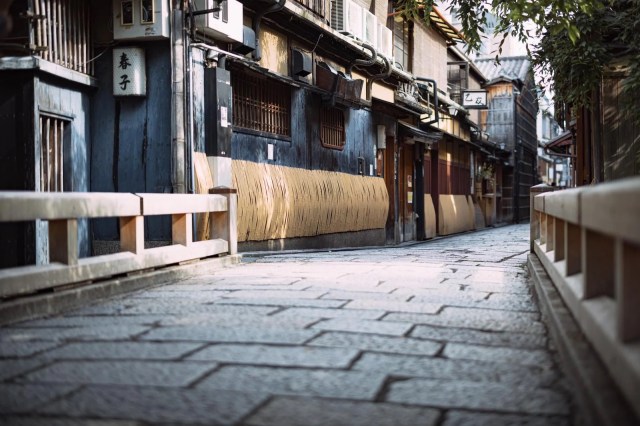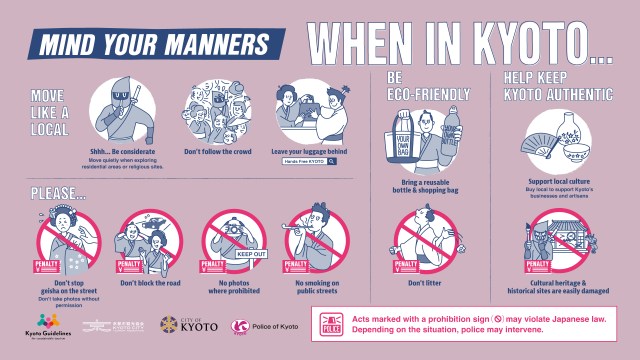Kyoto bans tourists from geisha alleys in Gion, with fines for those who don’t follow rules

Historic area wants foreign visitors to know it’s not a theme park.
Kyoto has found itself in a difficult position over the years, juggling the needs of residents with the needs of tourists who have inundated the ancient capital in increasing numbers, leading to the problem of overtourism.
One area struggling more than most is Gion, which, despite being a place of work and residence for many locals, has been treated like something of a theme park by tourists, who have been known to chase and photograph geisha and maiko (trainee geisha) in the area. An association made up of local residents and shop owners has attempted to curb the problem by forbidding photography on private roads, with fines of 10,000 yen (US$66.54) for violators, but with the issue still persisting, they’re now introducing even stricter restrictions, by banning tourists from entering alleyways.
▼ The photography ban was introduced in October 2019, after one geisha had part of her clothing torn and another had a cigarette butt inserted into her collar.
京都の人気の観光スポット、祇園で観光客によるマナー違反が深刻になっているとして、地元の協議会は、周辺の私道での写真撮影を原則、禁止にすることを決めました。https://t.co/Bga3PwZPDu#nhk_news pic.twitter.com/RuOPnGO0v6
— NHKニュース (@nhk_news) October 25, 2019
As the video above shows, the photography ban was introduced on “私道” (“shidou”), or “private roads”, which tend to be particularly appealing to out-of-towners due to their narrow, secluded appearance. However, private roads like these, which exist all over Japan, are owned and maintained by individuals or corporations and designed to only be used by those who live or work on the road, unlike public roads, which are owned by the government and open to the public.

As shidou are considered private property, the road owners are well within their rights to restrict access, and that’s what’s now happening in Gion, with new signs being put in place on the private roads, and fines of 10,000 yen being introduced for those who violate the rules.
Gion Southside District Council Director Isokazu Ota spoke to the media about the new restrictions, saying it was a move they didn’t want to take but felt forced to, as the stress on locals had become too great, with their “livelihoods now threatened“. In addition, roads are narrow and can easily become overcrowded, posing a danger to both residents and tourists, especially in the presence of “maiko paparazzi“, the name given to tourists who follow local maiko and geisha and wait outside teahouses where they work.
▼ “Maiko paparazzi” can be seen following the young women in this cued-up video below.
Ota says the private roads in the area were previously accessible to the public due to the kindness of locals, who acknowledged the fact that foreign tourists might not realise they were trespassing on private roads. However, concerns have been raised for maiko and geisha who live and work on these roads, as apprentice geisha are often 16 to 17 years of age, and being hounded by strangers can be frightening, and potentially dangerous, for them.
Therefore, after six months of discussions, the council decided to restrict access to these roads from April, installing signs at the prohibited areas that read: “This is a private road, so you are not allowed to drive through it. There will be a fine 10,000 yen“. The English translation, however, is sadly misleading because even if you’re not driving, you aren’t permitted access, as “通り抜け” (“tourinuke”) on the sign translates as “pass through”, which means the sign actually reads: “This is a private road, so you are not allowed to pass through it. There will be a fine 10,000 yen“.
▼ So if you see any of these signs, turn around.
One of the private roads that will be off-limits to tourists from April is shown in this report below. As you can see, the disruption is substantial, with walking tours and even a cycling tour making its way down the narrow private road.
The ban will come into effect from 1 April, with the prohibited roads marked in red at this point in the video below. Other roads, including the main public ones shown in blue — Shijo-dori Street on the horizontal axis and Hanamikoji Street on the vertical axis — will remain open to the public.
The commencement of the new ban is set to coincide with sakura season, when tourist numbers surge in the area. With foreign visitors to Japan totalling 2,488,100 in January alone, tourists are returning to the skyrocketing levels they were at before the pandemic, so Gion is taking every precaution to protect the area, and the livelihoods of residents, as overtourism shows no signs of stopping.
▼ The new restriction will be added to these other rules tourists are asked to abide by when visiting Kyoto.

So if you or someone you know is travelling to Kyoto, be sure to pass on the message to mind your manners and abide by the rules, because as this new restriction shows, the more tourists disrupt the area, the more prohibitions will be put in place, so abiding by the rules will make life better for everyone.
Sources: ANN, FNN
Featured image: Pakutaso
Insert images: Pakutaso, Kyoto City Tourism Association
● Want to hear about SoraNews24’s latest articles as soon as they’re published? Follow us on Facebook and Twitter!
Credit:

0 comments: